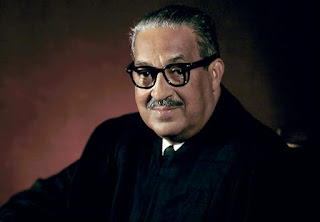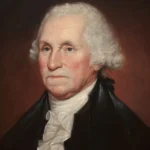
Thurgood Marshall was the first African-American Supreme Court Justice in the United States, and he was one of the twentieth century’s most influential Civil Rights advocates, being responsible for the end of school segregation. Thurgood Marshall was born in Baltimore, Maryland, on July 2, 1908, to Norma Marshall, a kindergarten teacher, and William Marshall, a railroad porter. Thurgood was a good student who graduated from high school a year early before going on to Lincoln University, where he earned an honors degree in American literature and philosophy. Thurgood then attended Howard University School of Law, where he earned his law degree in 1933. His legal career and Civil Rights work eventually led to his appointment as the Supreme Court’s first African-American justice.
Thurgood Marshall’s great grandfather was a slave who had been brought to the United States from Africa, where he was born.
Thurgood Marshall’s name was originally Thoroughgood, but he shortened it to Thurgood in second grade because he was tired of spelling it out.
Thurgood Marshall went to Lincoln University after applying to be a dentist, but he decided to become a lawyer instead.
Thurgood enjoyed playing pranks and even got himself into some trouble while attending Lincoln University.
Thurgood met his wife (Vivian Burey) at Lincoln University, and they married while he was still a student.
Thurgood wanted to study law at the University of Maryland, but segregation prevented him from doing so, so he attended Howard University of Law instead.
Thurgood Marshall began working in private practice in Baltimore after graduating from Howard Law.
Thurgood Marshall represented the NAACP (National Association for the Advancement of Colored People) in Murray v. Pearson, a law school discrimination case, in 1934. The case concerned an African-American student who was denied admission to the University of Maryland due to segregation laws. He won the case, which was the first of several that would challenge and eventually end racial segregation.
Thurgood Marshall rose quickly through the ranks to become the NAACP’s chief counsel.
Thurgood Marshall won Chambers v. Florida, his first Supreme Court case, at the age of 32, establishing that police coercion did not result in usable confessions.
Thurgood Marshall won the landmark case Brown v. Board of Education of Topeka in 1954, which ended school segregation.
Vivian Thurgood, Thurgood’s wife, died in 1955. He remarried Cecilia Suyat, with whom he had two sons.
Thurgood Marshall was appointed as a circuit judge by President John F. Kennedy in 1961. He was the U.S. For four years, he was a judge on the Second Circuit Court of Appeals. During this time, the Supreme Court never overturned any of his 100 decisions.
In 1965, President Lyndon B. Johnson appointed Thurgood Marshall as the nation’s first African-American solicitor general. Thurgood won 14 of the 19 cases he argued over the next two years.
Thurgood was appointed to the Supreme Court by President Lyndon B. Johnson in 1967.
Thurgood Marshall was sworn in as a Supreme Court Justice on October 2, 1967, becoming the country’s first African-American to hold the position.
Thurgood was a Supreme Court Justice for 24 years, retiring in 1991 after presiding over numerous landmark cases.
Thurgood Marshall died on January 24, 1993, at the age of 84.









